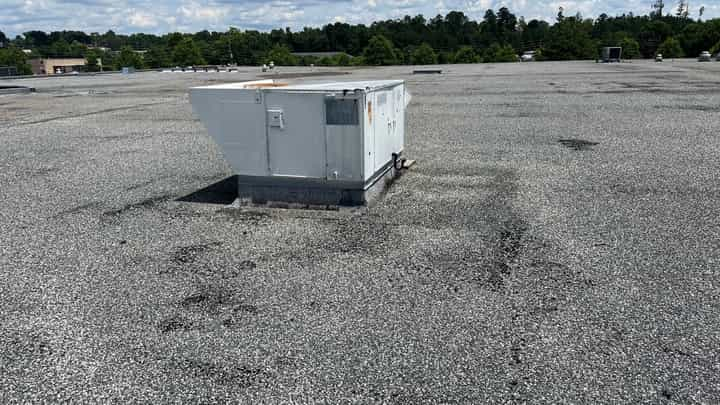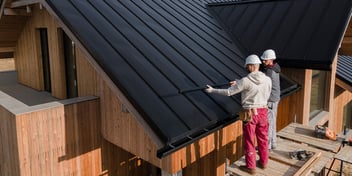- Home »
- Learningcenter »
- Flat roofing materials
The Complete Guide to Flat Roofing Materials - 2023 Edition
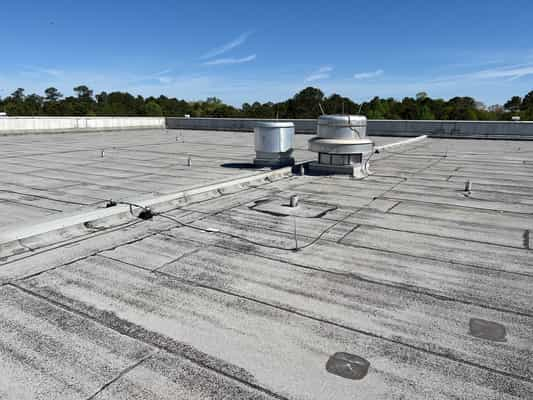
What is Flat Roofing?
Flat roofing refers to a type of roofing system that has a minimal slope, usually less than 10 degrees, and is generally used in commercial and industrial buildings. It differs from sloped roofs, which have a steeper incline and are more commonly found in residential buildings. Some of the most popular flat roofing materials include EPDM, TPO, and PVC, which are durable and long-lasting.
Most Common Types of Flat Roofing Materials
The most common types of flat roofing materials are:
- EPDM (Ethylene Propylene Diene Monomer) : It's a synthetic rubber membrane that is known for its durability and flexibility. EPDM is resistant to UV rays, ozone, and extreme temperatures, making it a great option for flat roofs.
- TPO (Thermoplastic Olefin) : A single-ply roofing membrane made from thermoplastic polyolefin. It's a popular choice for flat roofs due to its energy efficiency and ability to reflect UV rays.
- PVC (Polyvinyl Chloride) : It's a thermoplastic material that is known for its durability and resistance to chemicals, fire, and extreme temperatures. PVC is also energy efficient and UV resistant.
- Built-up Roofing (BUR) : It's a traditional roofing system made of multiple layers of felt or fiberglass, which are coated with tar or asphalt to create a waterproof barrier.
- Modified Bitumen: It's a type of asphalt-based roofing that is reinforced with either a polyester or fiberglass mat. It provides good durability and resistance to punctures and tears.
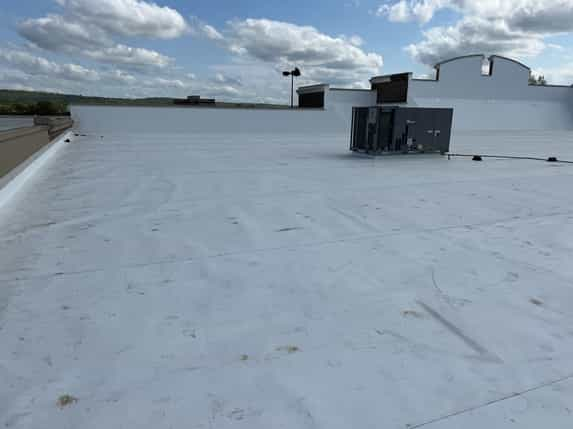
It's worth noting that each type of flat roof material has its own unique set of benefits and drawbacks. The best choice for your building will depend on factors such as location, climate, and budget.
Advantages and Disadvantages of Flat Roofing
Advantages of flat roofing:
- Cost-effective: Flat roofs are typically less expensive to install and maintain than sloped roofs. This is because they require less materials and labor to construct.
- Easy Access: Flat roofs are easy to access, which makes it convenient for maintenance and repairs. This can save time and money in the long run.
- Space: Flat roofs can be used as an additional outdoor space, such as for creating a rooftop garden or terrace.
- Energy efficient: TPO and PVC have reflective properties that can help to reduce the amount of heat absorbed by the building, which can lead to lower cooling costs.
Disadvantages of flat roofing:
- Drainage: Flat roofs can have drainage issues: if not properly designed and maintained. This can lead to water ponding, leaks, and other damage.
- Weather Damage: Flat roofs are more susceptible to damage from heavy rain and snow, as well as high winds.
- Not suitable for all climates: Flat roofs are not suitable for areas with heavy snow or frequent heavy rains, because of the risk of water ponding.
- Reduced lifespan: Without proper maintenance, flat roofs tend to have a shorter lifespan than sloped roofs.
It's worth noting that with proper design, installation, and maintenance, flat roofs can be a viable option for many buildings. It's important to consult with a professional roofing contractor to determine if a flat roof is the right choice for your specific building and location.
Flat Roofing Materials: A Deep-Dive
EPDM
EPDM (Ethylene Propylene Diene Monomer) is a type of flat roofing material that is made from synthetic rubber. It is a popular choice for flat roofing because of its durability and flexibility, making it resistant to UV rays, ozone, and extreme temperatures. EPDM roofing is a single-ply membrane that is available in large sheets, which allows for quick and easy installation. It can be installed with either adhesive or mechanical fasteners, and can be used on a variety of roofing substrates, including metal, concrete and wood.
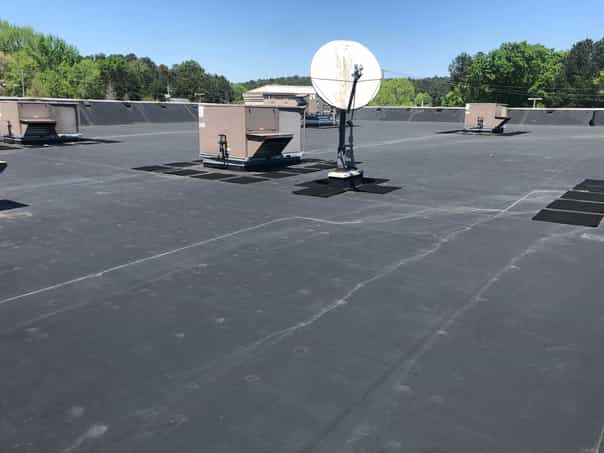
EPDM roofing has a lifespan of around 20-30 years, which is longer compared to other flat roofing materials, and it is relatively easy to maintain and repair. It is also eco-friendly as it made of recycled materials and it is highly resistant to ozone and UV rays, making it very energy efficient. EPDM roofing is available in both black and white. The white color can help to reflect sunlight, which can help to reduce the amount of heat absorbed by the building.
EPDM roofing is an excellent choice for flat roofing. However, it's not suitable for all buildings, particularly those with steep slopes or those located in areas with heavy snowfall or freeze-thaw cycles. It's important to consult with a professional roofing contractor to determine if EPDM roofing is the right choice for your specific building and location.
TPO
TPO (Thermoplastic Olefin) is a type of flat roofing material that is made from thermoplastic polyolefin. It is a single-ply membrane that is designed for use on flat or low-slope roofs. TPO membranes are becoming increasingly popular due to its energy efficient properties and ability to reflect UV rays. This can help to reduce the amount of heat absorbed by the building, resulting in lower cooling costs.
TPO roofing is available in a variety of thicknesses, and it is highly resistant to punctures, tears, and UV rays. It is also highly resistant to ozone and chemicals, making it a durable and long-lasting roofing solution. TPO roofing is a light-weight roofing material, which makes it easy to handle and install. It is also available in a variety of colors, including white, which can help to reflect sunlight and lower cooling costs.
TPO is installed using heat welding, which creates a strong and durable bond between the membrane and the roof deck. This type of installation ensures that the roofing material is watertight and airtight, which can help to prevent leaks and drafts.
TPO roofs are an excellent choice for flat roofing, however it's not suitable for all buildings, particularly those located in areas with heavy snowfall or freeze-thaw cycles. It's important to consult with a professional roofing contractor to determine if a TPO roof is the right choice for your specific building and location.
PVC
PVC (Polyvinyl Chloride) is a type of flat roofing material that is made from thermoplastic material. It is a popular choice for flat roofing because of its durability and resistance to chemicals, fire, and extreme temperatures. PVC roofing is a single-ply membrane that is available in large sheets, which allows for quick and easy installation. It can be installed with either adhesive or mechanical fasteners, and can be used on a variety of roofing substrates, including metal, concrete, and wood.
PVC roofing has a lifespan of around 20-30 years, which is longer compared to other flat roofing materials, and it is relatively easy to maintain and repair. PVC roofing is also energy efficient as it reflects UV rays and cools the building, resulting in lower cooling costs. PVC roofing is available in a variety of colors, including white, which can help to reflect sunlight and lower cooling costs.
PVC roofing is an excellent choice for flat roofing. However, it's not suitable for all buildings, particularly those with steep slopes or those located in areas with heavy snowfall or freeze-thaw cycles. It's important to consult with a professional roofing contractor to determine if PVC roofing is the right choice for your specific building and location.
Built-up Roofing (BUR)
Built-up roofing (BUR) is one of the oldest types of flat roof material. It is made of multiple layers of felt or fiberglass, which are coated with tar or asphalt to create a waterproof barrier. BUR is also known as "tar and gravel" roofing, because the top layer of the roofing system is typically covered with gravel or small stones. This protects the roof from debris and sunlight.
Built-up roofs have been used for many years, and it is a proven roofing system that is known for its durability and resistance to ponding water on a flat roof, as well as weather damage. The multiple layers of felt or fiberglass provide added strength and protection, and the tar or asphalt coating helps to create a waterproof barrier.
This type of roofing is relatively easy to install, and it is a cost-effective solution for flat roofs. It is also relatively easy to repair and maintain, and it can last for up to 20-30 years with proper care.
However, built-up roofing is not suitable for all buildings, particularly those with steep slopes or those located in areas with heavy snowfall or freeze-thaw cycles. It's also relatively heavy and it's not energy efficient, reflecting a minimal amount of UV rays. It's important to consult with a professional roofing contractor to determine if built-up roofing is the right choice for your specific building and location.
Modified Bitumen
Modified Bitumen roofing is a type of flat roofing material that is made from asphalt-based roofing that is reinforced with either a polyester or fiberglass mat. This type of roofing is similar to built-up roofing (BUR), but it uses a modified bitumen membrane instead of felt or fiberglass. This type of roofing offers good durability and resistance to punctures and tears.
Modified Bitumen roofing is relatively easy to install, and it is a cost-effective solution for flat roofs. It is also relatively easy to repair and maintain, and it can last for up to 20-30 years with proper care.
Modified bitumen membranes can be installed using different methods. Typical methods include:
- Torch down installation, where the membrane is heated and then adhered to the roof deck.
- Cold adhesive installation, where the membrane is applied using a cold-applied adhesive.
- Self adhered, where the membrane is simply stuck to the substrate using factory applied adhesive.
Modified bitumen roofing is suitable for flat roofs in most climates, and it offers good resistance to rain, snow, and high winds. It also offers good resistance to punctures, tears and other forms of damage.
However, modified bitumen roofing is not suitable for all buildings, particularly those located in areas with heavy snowfall or freeze-thaw cycles. It's important to consult with a professional roofing contractor to determine if modified bitumen roofing is the right choice for your specific building and location.
Which material is best for your flat roof?
In conclusion, flat roofing is a popular choice for many commercial and residential buildings, thanks to its low cost and ease of installation. There are several types of flat roofing materials available on the market, including EPDM, TPO, PVC, Built-up roofing and Modified bitumen. Each type of material has its own unique set of benefits and drawbacks, and the best choice for your building will depend on factors such as location, climate, and budget.
EPDM roofing is known for its durability and flexibility, making it resistant to UV rays, ozone, and extreme temperatures. TPO roofing is becoming increasingly popular due to its energy-efficient properties and ability to reflect UV rays. PVC roofing is known for its durability and resistance to chemicals, fire, and extreme temperatures. Built-up roofing is a traditional type of flat roofing material that is known for its durability and resistance to water and weather damage. Modified Bitumen roofing offers good durability and resistance to punctures and tears.
It's important to consult with a professional roofing contractor to determine the right choice of flat roofing material for your specific building and location. Proper design, installation, and maintenance can help to ensure that your flat roof lasts for many years and performs well in all weather conditions.
 Call (678) 365-3138
Call (678) 365-3138
